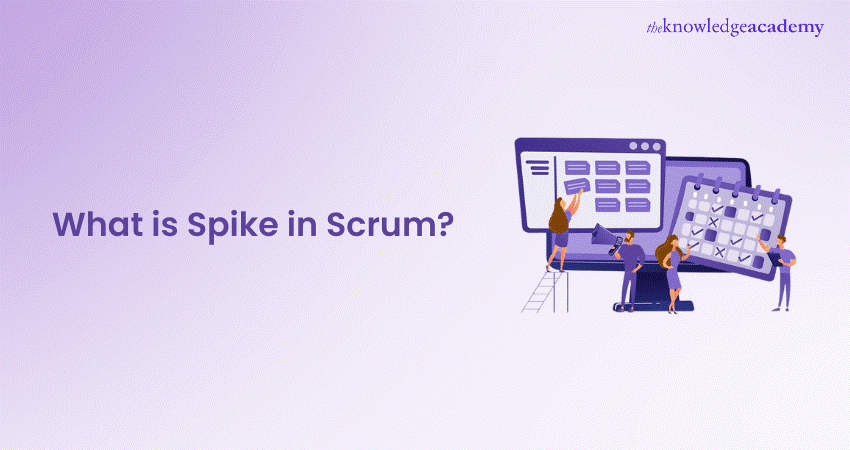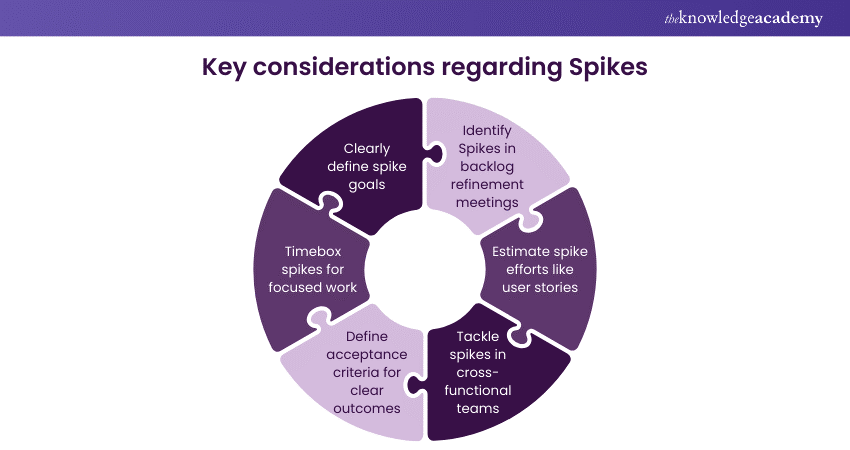We may not have the course you’re looking for. If you enquire or give us a call on +0800 780004 and speak to our training experts, we may still be able to help with your training requirements.
We ensure quality, budget-alignment, and timely delivery by our expert instructors.

Are you a Scrum team member aiming to optimise your project’s workflow and seeking the ideal approach to tackle complex tasks? If you’re new to Agile methodologies or looking to enhance your Scrum practices, understanding What is Spike in Scrum can significantly help with this. With the variety of Scrum Artifacts and events, the challenge lies in effectively integrating Spikes into your sprints.
A Spike is a backlog item distinctive to Scrum, aimed at solving a highly difficult to estimate problem or one that is quite unknown. In this blog, we will discuss What is Spike in Scrum and understand technical challenges, design issues, or feasibility questions related to it. This will greatly assist in accurate planning and execution of future work.
Table of Contents
1) What is Spike in Scrum?
2) When can you use Spike?
3) Different types of Spikes in Scrum
4) Key considerations regarding Spikes
5) Advantages of using Spikes in Scrum
6) Conclusion
What is Spike in Scrum?
A Scrum Investigation, also called Spike, aims to clarify the team’s doubts or incorrect estimate of a task. Normally time-limited, Spikes' purpose is to research new technologies, explore possible solutions, or better understand an involved problem.
The intention is to minimise risk and use precise planning to make informed decisions and provide the required information. Spikes are good to go in Agile environments where the team brings flexibility and adaptability, helping to navigate the path of unknowns well for subsequent development works.
When can you use Spike?
A Spike, for instance, can be a necessary tool for uncovering unknowns or solving a complex issue hindering a team's speed in the Agile development process. In the case of a technical challenge with many ways out, a spike can easily go through them to choose the right solutions.
Additionally, when a new technology or tool is being planned for incorporation into a project, Spike will give a concentrated period for researching and experimenting to determine feasibility and possible impact. It's also helpful for providing evidence for decision-making, collecting information, and refining user stories to obtain correct preparation and estimation.
Different types of Spikes in Scrum
In Scrum, Spikes are mainly of two types, and each has a different goal for removing the uncertainties of a project. Let's discuss these types:

1) Functional Spike
A Functional Spike examines issues related to the application's functions to better understand the user's requirements and needs. Such a Spike is suitable when there is ambiguity regarding how a feature should work from the user's standpoint or when the team may need to verify the assumptions regarding user interactions.
The ultimate target is to investigate viable options, make informed decisions to improve the User Experience, and ensure that the development corresponds to user expectations and requirements.
2) Technical Spike
Technical Spikes are concentrated on intellectual confusion arising from a project's technical aspects. This could be done by studying new technologies, tools, or frameworks to learn whether they are consistent with the project's purpose, resolving complicated technical problems, or choosing a particular technical method to implement a feature.
They help the team manage the risks associated with technical issues, ensuring that architecture and tech stacks meet the project's long-term goals and objectives.
Are you interested in learning more about the different roles and responsibilities of Scrum team? Register now for our Scrum Developer Training!
Key considerations regarding Spikes
Here are some key considerations that you need to consider regarding Spikes:
1) Clearly define spike goals
The success of Spike begins with a clear grasp of what it stands for. Before launching it, it is imperative to define Spike's primary questions or ambiguities, which it purposes to solve or answer.
The team goal has to be unambiguous so that it is not off the mark and team effort is channeled toward progress of the project and the outcomes of the spike can be eliminated to actionable and meaningful contributions. This clarity assists by pinning down the target in the direction of the whole goal.
2) Identify Spikes in backlog refinement meetings
Spikes are identified during backlog refinement meetings, where the team reviews and prioritises backlog items. Identifying Spikes at this stage allows for strategic planning. It ensures that they are integrated into the sprint with a clear understanding of their impact on the team's capacity and the sprint's goals. It also lets the whole team contribute to the definition and scoping of the Spike.
3) Estimate spike efforts like user stories
However, when it comes to development, Spikes differ from user stories, which require an estimate of the effort for sprint planning. Viewing Spikes as user stories about pointing allows for managing team capacity and ensuring that the time spent on Spikes does not detract from completing the rest of the sprints.
4) Tackle Spikes in cross-functional teams
Many times, Spikes cover fields in which individuals' differing perspectives and talents are all needed. Include staff members from different departments or functions to ensure a thorough investigation of the challenges. Interaction inspires people to exchange information and concepts, culminating in comprehensive research and unique approaches. Furthermore, it creates belongingness that transmits to the whole team.
5) Define acceptance criteria for clear outcomes
Along with user stories, Spikes have clear acceptance criteria to make the success clear. These criteria offer a good basis for evaluating Spike's outcomes and provide meaningful information that can be applied to the project and produce results. Acknowledging the precise acceptance criteria allows the team to get the things done and check if the Spike fully aligns with its purpose.
6) Timebox Spikes for focused work
Scrum Timebox is fundamental for the project completion on time and effectively utilising Spike meetings. Through Spikes's duration restriction, i.e., a solitary sprint, time-boundedness becomes the prime factor persuading teams to work with focus and speed. Timeboxing eliminates the possibility of Spikes stretching on and on until they lose their reason to exist and become a stumbling block instead.
Do you want to learn about the key concepts of Agile and Scrum? Sign up now for our Managing Agile Projects with Scrum Course!
Advantages of using Spikes in Scrum
Incorporating Spikes into Scrum processes brings numerous benefits that streamline and enhance project outcomes:
a) Clarifies complex issues: Spikes go deep to the areas of complexity or ambiguity, providing clarity and eliminating points of dispute, smoothing out the development process.
b) Supports accurate estimations: They help resolve uncertainties, thus making task time and resource estimations more accurate and improving the accuracy of Sprint Planning.
c) Promotes technical exploration: They provide a secure background for technical research and discovery of new technologies or approaches, which leads to creativity and efficient solutions.
d) Enhances team collaboration: Spikes imply collaboration among team members, where different skills and visions are used to solve problems, leading to team cohesion and effectiveness.
e) Facilitates knowledge acquisition: Spikes allow users to acquire new skills and knowledge, fueling personal and team growth.
f) Increases product quality: They enable in-depth research and problem solving, which leads the company to produce high-quality features and products.
g) Enables risk mitigation: Spikes helps mitigate risks at the time of the project initiation, thus preventing them from becoming a substantial problem later on.
h) Optimises resource allocation: Time invested in Spikes allows for application of resources to where they matter the most, thus avoiding unnecessary allocation of resources to tasks that do not require much effort.
Do you want to learn how to become efficient in Scrum? Then register now for our Scrum Certification Training!
Conclusion
We hope that from this blog you understood What is Spike in Scrum and how it enhances agility, efficiency, and success of Scrum projects. These not only improve the Agile process but also help teams to navigate challenges. Spikes are not merely enhancements to the Agile process; they are pivotal in equipping teams with the tools to overcome obstacles and navigate through the complexities of project development. By incorporating Spikes into their Scrum workflow, teams can address uncertainties proactively, ensuring a smoother progression towards their goals.
Learn the different Agile Project Management methodologies with our Scrum for Teams Course – join now!
Frequently Asked Questions
What are Spike tasks in Agile?

Spike tasks in Agile are exploratory activities which are conducted to determine the answer to the given question, or to find an immediacy to guide the future work, so it is easy to plan and execute it correctly.
What is the difference between Story and Spike in Scrum?

The difference between a Story and a Spike in Scrum lies in their purpose: Narratives just deliver utility improvements with incremental existent features, and Spikes on the other hand focus on unrevealing-risky opportunities and issues with no direct end-user's value.
What are the other resources and offers provided by The Knowledge Academy?

The Knowledge Academy takes global learning to new heights, offering over 3,000 online courses across 490+ locations in 190+ countries. This expansive reach ensures accessibility and convenience for learners worldwide.
Alongside our diverse Online Course Catalogue, encompassing 19 major categories, we go the extra mile by providing a plethora of free educational Online Resources like News updates, Blogs, videos, webinars, and interview questions. Tailoring learning experiences further, professionals can maximise value with customisable Course Bundles of TKA.
What is Knowledge Pass, and how does it work?

The Knowledge Academy’s Knowledge Pass, a prepaid voucher, adds another layer of flexibility, allowing course bookings over a 12-month period. Join us on a journey where education knows no bounds.
What are related Leadership Courses and blogs provided by The Knowledge Academy?

The Knowledge Academy offers various Scrum Certification Training, including Scrum Master Certification Training, Scrum Developer Training, and Scrum for Teams course. These courses cater to different skill levels, providing comprehensive insights into Scrum Tools
Our Project Management Blogs covers a range of topics related to Scrum, offering valuable resources, best practices, and industry insights. Whether you are a beginner or looking to advance your Scrum skills, The Knowledge Academy's diverse courses and informative blogs have you covered.
Upcoming Project Management Resources Batches & Dates
Date
 Scrum Master Certification
Scrum Master Certification
Thu 20th Feb 2025
Thu 27th Feb 2025
Thu 6th Mar 2025
Thu 13th Mar 2025
Thu 20th Mar 2025
Thu 27th Mar 2025
Thu 3rd Apr 2025
Thu 24th Apr 2025
Thu 1st May 2025
Thu 22nd May 2025
Thu 5th Jun 2025
Thu 19th Jun 2025
Thu 3rd Jul 2025
Thu 17th Jul 2025
Thu 31st Jul 2025
Thu 14th Aug 2025
Thu 11th Sep 2025
Thu 25th Sep 2025
Thu 2nd Oct 2025
Thu 9th Oct 2025
Thu 16th Oct 2025
Thu 23rd Oct 2025
Thu 30th Oct 2025
Thu 6th Nov 2025
Thu 13th Nov 2025
Thu 20th Nov 2025
Thu 27th Nov 2025
Thu 4th Dec 2025
Thu 11th Dec 2025
Thu 18th Dec 2025






 Top Rated Course
Top Rated Course



 If you wish to make any changes to your course, please
If you wish to make any changes to your course, please


